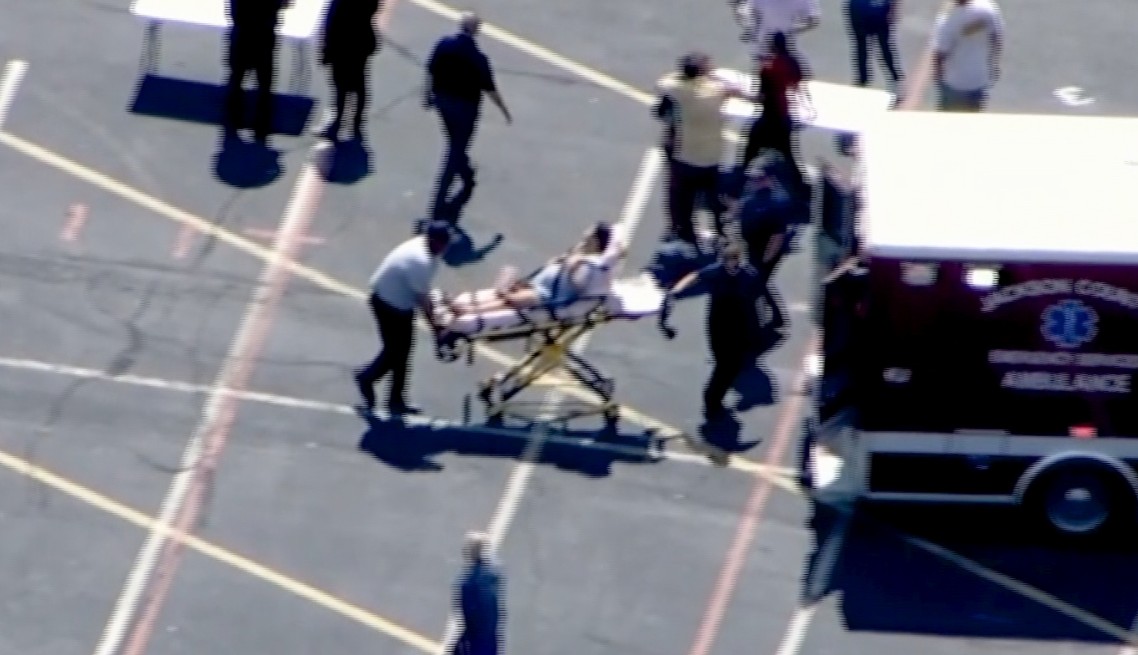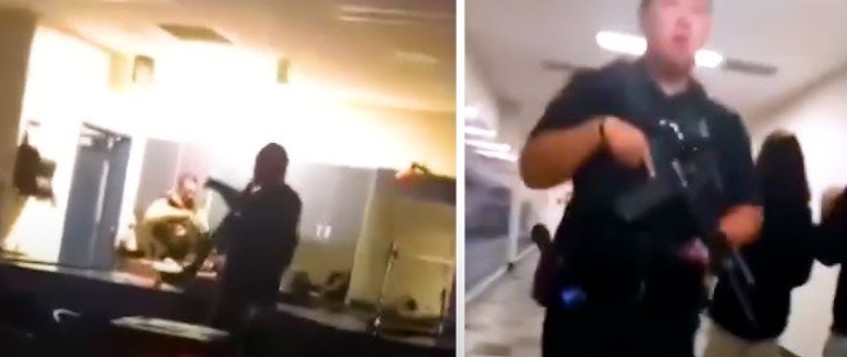Georgia School Shooting Video and Public Reaction
On a devastating Wednesday in Winder, Georgia, the peace of Apalachee High School was shattered when a 14-year-old student opened fire inside the building. Normally filled with energy and learning, the school became the scene of unimaginable violence. Armed with an assault-style rifle, the shooter killed four people two classmates and two respected teachers plunging the community into shock and grief. The Georgia school shooting video captures the chaos and urgency of the moment, showing students and staff reacting under extreme fear and pressure.
As gunshots rang out through the corridors, the school’s swift lockdown procedures came into effect. Students scrambled to secure themselves, turning classrooms into barricaded shelters. In junior Layla Ferrell’s health class, the words “hard lockdown” flashed across a screen, triggering an immediate response. Desks and chairs were stacked against doors, and students huddled together, bracing for danger. Fear was overwhelming, but the determination to survive pushed these young people to act decisively.

Teachers outside the classrooms displayed equal courage, stepping into the role of first responders. Some used their clothing to stop bleeding, while others tended to the wounded until paramedics arrived. Meanwhile, school resource officers quickly located the shooter. Confronted within minutes of the attack, the assailant surrendered without further violence. This rapid police intervention, combined with staff efforts, prevented an already horrific situation from escalating further.
This tragic day at Apalachee High underscores the grim reality of a growing crisis: school shootings that continue to destabilize communities and traumatize students across the United States. Beyond the immediate devastation, the incident raises urgent questions about campus security, access to firearms, and the lasting emotional toll such tragedies leave on young people and educators.
Contents
Incident Details and Video
The normal midday rhythm of Apalachee High School was violently disrupted just before noon, when the young gunman began his attack. What should have been an ordinary school day instantly turned into a nightmare. Four lives were lost in the shooting, leaving the school and the wider community grieving deeply.
Georgia School Shooting Video
georgia-school-shooting-video.mp4
The victims were identified as two students, Mason Schermerhorn and Christian Angulo, both only 14 years old, along with two teachers, Richard Aspinwall and Christina Irimie. All four were cherished members of the school, and their loss has left a painful void among classmates, colleagues, and families.
The shooter also a student at the school was taken into custody almost immediately after the attack began. Thanks to the swift action of school resource officers, who confronted him within minutes, the assailant surrendered without resistance. Their rapid intervention not only limited the extent of the tragedy but also enabled a faster lockdown to safeguard the rest of the students and staff.
Eyewitness Accounts
Amid the chaos, firsthand testimonies reveal the raw fear, courage, and survival instincts of those inside Apalachee High School.
Junior Layla Ferrell described how her health class transformed in an instant. What was normally a place of laughter and routine turned into a fortress of desperation when the alert for a “hard lockdown” appeared on the screen. With trembling urgency, she and her classmates stacked desks and chairs against the door, their makeshift barricade a fragile shield against the terror lurking outside.
Sophomore Kaylee Abner faced the nightmare in her geometry classroom. The moment gunshots rang out, panic swept the room. Guided by their teacher, students flipped desks and crouched behind them. Despite the sound of gunfire, Kaylee found a strange comfort in holding the hand of a classmate who prayed for protection a small act of unity that carried profound meaning in such a terrifying moment.

For parents, the ordeal carried its own kind of torment. Erin Clark, whose son Ethan was among those trapped inside, received a chilling text message from him about the active shooter. Dropping everything at her job in a nearby Amazon warehouse, she sped to the school. The texts exchanged during her frantic drive filled with love, fear, and urgency captured the essence of a parent’s instinct to protect. Relief overwhelmed her when she finally saw Ethan, safe but shaken, sitting in the bleachers among other survivors. Her story reflects the deep emotional scars these events leave on families.
These accounts students building barricades with trembling hands, a mother racing desperately to her child, classmates clinging to one another offer a window into the personal and collective trauma inflicted by school shootings. At the same time, they highlight the resilience, quick thinking, and bravery of those who faced the unimaginable and fought to protect themselves and others.
Law Enforcement and Emergency Response
The swift actions of law enforcement were crucial in containing the violence at Apalachee High. Within minutes of the first 911 calls, two school resource officers responded directly. They confronted the shooter, who surrendered without resistance, preventing additional casualties. The rapid response underscored the vital role of trained security personnel stationed in schools, ready to act when every second matters.
Equally critical was the medical response. Teachers and staff immediately stepped in, improvising first aid with whatever they had on hand tearing fabric to stop bleeding and offering comfort to the wounded until paramedics arrived. Emergency responders worked quickly and efficiently, transporting victims to nearby hospitals where doctors soon offered a rare glimmer of hope: despite the violence, all of the injured were expected to survive.
The coordinated effort between educators, first responders, medical professionals, and law enforcement transformed what could have been an even greater tragedy into an example of effective crisis management. Their actions demonstrated not only preparedness, but also the courage and determination to save lives under unimaginable pressure.
Background and Security Failures
The tragedy at Apalachee High School was preceded by warning signs and security shortcomings that, if addressed more effectively, might have prevented the attack. Months before the shooting, the FBI received anonymous tips warning that the student posed a potential threat. According to these reports, the teen had made online comments suggesting an intent to carry out a school shooting. The FBI conducted an investigation, narrowed down the lead, and then referred the case to the Jackson County Sheriff’s Office for local follow-up.
Deputies interviewed the 13-year-old suspect and his father. While the family acknowledged having hunting firearms in the home, they assured investigators that the child did not have unsupervised access to them. Based on this reassurance and without sufficient evidence to justify stronger intervention authorities decided to notify the schools for monitoring but took no further action. In hindsight, these measures proved inadequate.
How the shooter ultimately obtained and smuggled the weapon into school remains under investigation. What is clear, however, is that safeguards failed to keep guns away from someone who had already been flagged as a risk. This lapse reflects broader issues surrounding firearm storage and access, particularly in households with children.
Equally troubling was the ease with which the weapon was carried into the school. Whether due to insufficient screening tools, absent surveillance, or gaps in enforcement, existing security protocols did not prevent the introduction of an assault-style rifle onto campus.
These oversights highlight the urgent need for more robust threat-assessment processes, improved coordination between federal and local authorities, and stricter security measures within schools. The Apalachee High School shooting underscores just how vulnerable many educational institutions remain to acts of violence.
Community Reaction
In the wake of the tragedy, Winder, Georgia, and the nation responded with sorrow, solidarity, and renewed calls for change. Sheriff Jud Smith, his voice heavy with emotion, spoke directly to the pain of the community. Declaring that “hate will not prevail” in the county, he urged love and unity as the guiding principles in the aftermath of violence. His words struck a chord with residents, offering both comfort and resolve.
National figures also weighed in. Vice President Kamala Harris, while on the campaign trail, condemned the “outrageous” reality that parents must fear sending their children to school, highlighting the urgent national concern over recurring tragedies. Former President Donald Trump denounced the perpetrator as a “sick and deranged monster,” mourning the loss of young lives. Together, these statements reflected the broad political and social anguish that has accompanied each new school shooting in the United States.
Locally, grief was channeled into unity. Hundreds gathered in Jug Tavern Park for a candlelight vigil. Students and families from both Apalachee High and rival Winder-Barrow High came together, setting aside divisions to mourn as one community. Prayers, interfaith rituals, and moments of silence provided a space for collective healing and remembrance.
Despite years of active-shooter drills and heightened security, the Apalachee tragedy raises difficult questions about the effectiveness of current measures. School shootings remain disturbingly frequent, yet meaningful reforms to address gun access and violence remain elusive. Each new incident fuels the debate over gun laws, mental health resources, and school safety but legislative progress has been limited.
Looking forward, many argue that preventing future tragedies requires a multi-layered response: stronger gun control policies, expanded mental health support for students, stricter firearm storage laws, and more comprehensive school security systems. Community-driven education and awareness programs may also play a critical role in identifying threats before they erupt into violence.
In the face of profound loss, the people of Winder demonstrated resilience and unity. Their response serves as a reminder that even in moments of despair, collective strength and compassion can light the path toward healing and perhaps, toward change.
Daily News -Shannon Sharpe Instagram Live Video Incident Explained
Isabella Ladera y Beele video viral con Erome and Scandal
Yailin and Tekashi Video Leak Triggers Online Debate
Whitney Wren and Christen Whitman Video Leak Drama Unfolds
Heccymar TikTok Video Viral Completo and Digital Privacy Leak
McKinley Richardson Video Leak and Public Impact
Luz Arias Video Leak and the Response It Sparked

